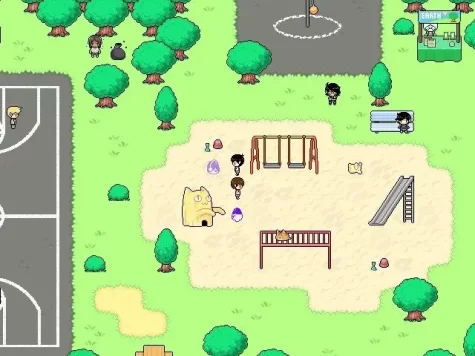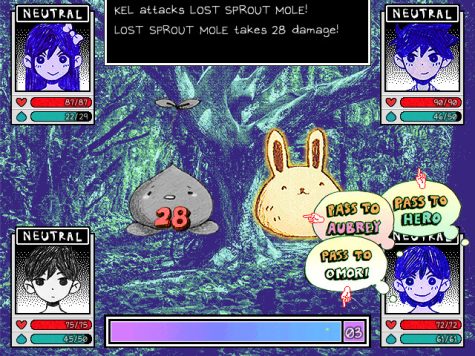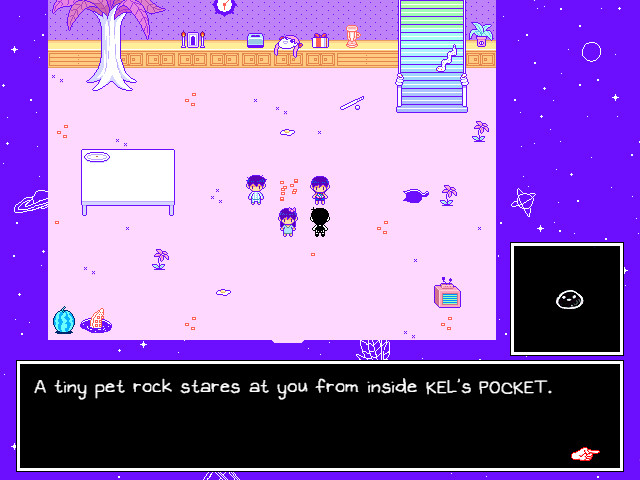Those looking for a happy (yet depressing) story should try “OMORI”
Photo by Google Images
A layout of the games overworld, pixelated RPG like exploration
September 28, 2022
![]()
By now, you are probably bored with the video games you have been playing for months on end, and are looking for a new game to play – one that is different from others. Well, why not try “OMORI”, the award-winning game that PC Gamer magazine calls a “modern cult classic.”
“OMORI” is a pixelated video game created by OMOCAT, published on December 23, 2020, after nine years in production. Originally, the game was released solely on computer, but on July 17, 2022 the role-playing game came out on consoles such as PlayStation, Xbox, and Nintendo Switch. With the move to console, OMOCAT, an indie gaming company, added more content to the game as well.
“OMORI” centers around a boy named Sunny (OMORI) who is dealing with the trauma of his sister’s death. As he ventures off into his dream world, the player slowly reveals the truth that has been locked away in the back of Sunny’s head.

From what can be seen of online reviews, people really love this game, citing the story, original soundtrack (ost), gameplay, and depth of characters.
Story is very important when talking about a video game, especially a role-playing one (RPG). In “OMORI”, a young boy has not left his house for four years. Since his sister’s death, the boy stays in his room in his headspace (dream world) where he has everything he wants – in this case, an adventure with his in-real-life (IRL) friends in his head (headspace version) to find his lost best friend, Basil.
This information may seem confusing at first. Sunny’s best friend, Basil, and other friends are real, but he pictures them differently in his mind – he only remembers them as they were at the age of 12, so their appearance is that of a child.
The game is deeper than a mission to find a missing pal, however. In the real world, Sunny has to face reality/trauma, as every step he takes in the story’s progression leads him closer to the truth of Mari’s, his sister’s, death. The plot is interesting: a dark and tragic story that players do not see in other games. Sunny also has to deal with three fears, including heights, drowning, and
The game’s fighting mechanics are based on attacks, but complicated by the character’s emotions. When Sunny and his friends Kel, Hero, and Aubrey are happy, ecstatic, or even manic, these emotions increase their speed and do more damage to angry foes.

When sadness, depression, or misery overtake Sunny, he moves into defense, and does more damage towards happy foes.
There are very few games in which feeling angry, enraged, or furious influence the character physically and mentally. In a normal RPG, yes, these emotions are included, but the fight motions are not based on them. They consist of normal attacks with typical weapons, usable items, food for healing. Those who like RPGs with emotion-based gameplay, should give “OMORI” a go.
One final reason to check out this pixelated game is that the characters are interesting and lovable. Sunny’s friends, Kel, Aubrey, Hero, and Basil, all have a unique design and go through substantial character development. Players will feel a connection to the characters, who are all unique in their own way. For example, Kel is a reckless, excited child who still appears immature in Sunny’s headspace, while in reality, he has matured and is also still dealing with his group’s separation following Mari’s death.
In Sunny’s headspace, everyone looks different; he only remembers how his friends appeared as children since he has not left his house. His trauma keeps him locked in his youth, so in his head, some people look more like toys, creatures, or even animals. Players therefore get to see both sides of the character, and that set-up is unique to “OMORI”.
Overall, “OMORI” is highly recommended. The game’s story, gameplay, and loveable characters will appeal to people who are looking for a fun game. That said, the game does have darker, more depressing elements, so it may not be for everyone.
The game retails for $30 everywhere but mobile.













![[PHOTO ESSAY] Behind-the-scenes with Chief of Police, Mike McLean](https://wildcatchronicle.org/wp-content/uploads/2024/04/Police-7-2023-Zach-Wiegele-2-600x429.jpg)


